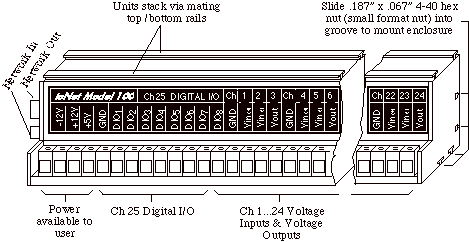SPECIFICATIONS for i100, i100B and i100HC
Fig 6.2 Model 100xx Network Device Connector Layout. This is a digital I/O port consisting of 8 individual lines, each of which can be configured as either a digital input channel or a digital output channel. When configured as an input, a channel can be used to sense a digital high (3.2V to 10Volts) or digital low (0 to 1Volts). When configured as an output a channel can be set high (2.0V min) or low (.5V max). The inputs are protected against high voltages up to +12Volts and down to -12V, before permanent damage occurs to internal circuitry.
Table 6.2 Model 100, 100B, and 100HC Technical Specifications. These are voltage input ports that can be wired for many different types of sensors. When wiring single-ended inputs the Vin+ and Vin- terminals function identically.
Voltage Measurement Accuracy
1Measurement Accuracy: 0-70°C, no condensation, #iNet-100xx Rev 3, temperature has not changed since self-calibration, Accuracies are typical within 2 standard deviations. Accuracy is effected by the Channel Switching field (i.e. set in the Setup dialog to Accurate or Fast) and the integration time. If the Channel Switching field is set to Accurate, the signal is given more time to settle after the channel multiplexor is switched. Accurate switching has a lower maximum sample rate than Fast switching. 2Integration Time: Integration time is independently programmable for each channel, and reduces noise by averaging many samples. Also, if more than 125 samples are averaged, a dithering noise generator automatically turns on to add noise to the input signal. This increases the accuracy further by using more a/d codes to establish the input volt. For details, click here. Thermocouple Measurement Accuracy with the i100 instruNet supports a direct connection to thermocouples with the following measurement accuracies. The table excludes thermocouple device errors; yet includes cold junction compenstation errors, voltage measurement errors, and linearization errors.
3CONDITIONS: 18-28C ambient temperature around instruNet hardware, excludes thermocouple errors, 0.001 sec of integration, instruNet 100 #iNet-100 Rev 3, assumes temperature has not changed since instruNet 100 self-calibration. Thermistor Measurement Accuracy with the i100 The instruNet 100HC supports the direct connection to YSI/Omega 4xx and 4xxxx series thermistors, requiring one external shunt resistor. The following table shows accuracies with 2 different kinds of shunt resistors (i.e. 0.025%-20ppm/C and 0.1%-25ppm/C resistor). The table excludes thermistor device errors; yet includes thermistor and shunt self-heating errors, shunt initial accuracy errors, voltage measurement errors, and linearization errors.
4Conditions: 18-28C ambient temperature around instruNet hardware, excludes thermistor errors, 0.001 sec of integration, instruNet #iNet-100HC Rev 3, assumes temperature has not changed since instruNet 100 self-calibration. These are voltage output ports that can be used for purposes such as stimuli and sensor excitation.
Power Available to End User The +5V, -12V, and +12V screw terminals can be used to power external devices. The maximum allowed current specified in the below table should not be exceeded, else the controller and/or the computer could be damaged. To power an external device, run a wire from a voltage output terminal (e.g. "+5V) to the device and also run a wire from one of the ground terminals (i.e. "GND") to the device ground.
Network Interface The Model 100 cables to a Controller and/or other Network Devices via DB-25 cables.
Physical/Environmental All I/O signals cable to the Model 100 via screw terminals.
5Internal Power: Power consumed by the Model 100 Network Device without additional Network Devices attached, without a terminator, and without outputs loaded. Total system power consumption is the sum of the power consumed by the Controller and each attached Network Device. Stability and Drift The instruNet 100 (part #iNet-100 or iNet-100B) has the following Stability and Drift Characteristics:
The primary error from the i100 measurement electronics is an offset voltage of approximately 2uV/C that occurs at the analog voltage measurement input amplifier. This means you will get an offset error of approximately 2uV for every 1 degree C that the amplifier IC heats up. It heats approx 5C above ambient (air around instruNet box) when first turned on and stabilizes after 1hr or so. From here, the IC temperature changes as the room temperature changes (e.g. a 5C increase in room temperature will increase the IC temperature by 5C, which could add voltage measurement offset error of 10uV). When Auto Calibration is run, this error is eliminated to 0uV. Auto-Calibrating the i100 While Digitizing The i100 can automatically calibrate out thermal offset drift errors (e.g. 2uV offset error per 1C change in i100 box temperature) while digitizing. These errors are proportional to the temperature change since the last auto-calibration. For example, if we calibrate the i100 at 25C (i100 box temperature), and later the box temperature is 29C, then the Voltage inputs will produce measurement errors between -8uV and +8uV (2uV/C * 4C = 8uV). In many cases; this is not a problem; yet with strain gages, load cells and thermocouples; this could be an issue. In order for this auto-calibration of thermal offset errors (to zero error) while digitizing to operate, all the 40/4KHz analog filters must be off on all channels within the i100xx box being calibrated; and, there must be at least 6ms of time between the total integration time and the sample period. For example, if one digitizes 4 channels with 4ms integration each (16ms total), they would need a sample period of at least 20ms to support this feature. To see which channels are set up for auto-calibrate offset drift while digitizing, set up your recording, press the START button to digitize for several seconds, press STOP, enter "calibrate reportOn" in the BASIC page, press EXECUTE, and view the listed channels. If your list is empty, make sure your AUTO CAL RATE field is >0, make sure all 40/4KHz filters are off, and make sure at least one channel has a range <= ±80mV (large ranges are not affected.
|
